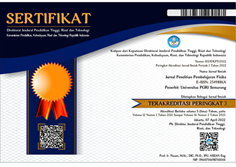Development of Counseling Sites with Digital Accessibility Features for the Blind and Visually Impaired Students
DOI:
https://doi.org/10.26877/asset.v7i1.1157Keywords:
Web Accessibility, Accessible Counseling Services, Disability Inclusion, Assistive Technology, ADDIE modelAbstract
Current counseling services, such as those available through sikons.upgris.ac.id, lack full accessibility for students with disabilities, particularly those who are blind and visually impaired. Studies reveal significant accessibility barriers across educational websites, impeding equal access for users with disabilities. This study addresses these gaps by developing an accessible counseling platform aligned with Web Content Accessibility Guidelines (WCAG) to ensure inclusive access for all students. Using the ADDIE model's structured stages of Analysis, Design, Development, Implementation, and Evaluation, this study aims to create a technically advanced, user-centered application that enhances usability and independence for students with disabilities. Results from user acceptance testing with 11 participants indicated a high satisfaction rate of 89,33%, demonstrating that the platform effectively meets users' needs, significantly improving accessibility and usability in educational counseling services. This outcome underscores the importance of integrating accessibility standards to foster inclusivity and equitable participation in digital educational resources.
References
[1] I. Fitria, U. Rahma, Z. Hikmiah, T. H. Firmanda, and R. F. Naim, “Counseling Design for Students with Disabilities at Brawijaya University Malang:,” presented at the 1st World Conference on Social and Humanities Research (W-SHARE 2021), Makassar, Indonesia, 2022. doi: 10.2991/assehr.k.220402.029.
[2] B. D. Wiyono and M. S. Haq, “E-Counseling for Children with Disabilities,” in Advances in Social Science, Education and Humanities Research, volume 388, pp. 69–72.
[3] M. Rivas, “AN EMERGING THEORY OF PERCEIVED DISABILITY COUNSELING COMPETENCE: A QUALITATIVE INVESTIGATION OF LICENSED PROFESSIONAL COUNSELORS,” Syracuse University, 2017. [Online]. Available: https://surface.syr.edu/cgi/viewcontent.cgi?article=1838&context=etd
[4] N. Georgoulas, “Counseling work in families of children with special needs,” in 5th International e-Conference on Studies in Humanities and Social Sciences: Conference Proceedings, Center for Open Access in Science, Belgrade, Jun. 2020.
[5] N. Patvardhan, M. Ranade, and K. Patvardhan, “Web Accessibility Supporting Diversity Inclusion and Effective Internet Communication in e-commerce, for Sustainable Social Development,” 2022 OPJU Int. Technol. Conf. Emerg. Technol. Sustain. Dev. OTCON, doi: 10.1109/OTCON56053.2023.10113942.
[6] Joanna Alexieva; and Pancho Tomov, “The Role of Digital Content Accessibility in Decision Making,” 2022 V Int. Conf. High Technol. Sustain. Dev. HiTech, doi: 10.1109/HiTech56937.2022.10145540.
[7] D. Rakhmawati, F. Murti Dewanto, and D. Maulia, “Developing a Prototype of Mobile-based Miko and Mila Animation Series Application Using the ADDIE Method,” KnE Soc. Sci., Sep. 2022, doi: 10.18502/kss.v7i14.11964.
[8] D. Kusumasari and E. R. Subhiyakto, “Development of Website-Based Stunting Prevention Educational Media Services (Case Study: UPT Puskemas Tirto Pekalongan),” Adv. Sustain. Sci. Eng. Technol., vol. 6, no. 2, p. 02402014, Mar. 2024, doi: 10.26877/asset.v6i2.18530.
[9] A. Pascual-Almenara and T. Granollers-Saltiveri, “Combining Two Inspection Methods: Usability Heuristic Evaluation and WCAG Guidelines to Assess e-Commerce Websites,” in Human-Computer Interaction, vol. 1478, P. H. Ruiz, V. Agredo-Delgado, and A. L. S. Kawamoto, Eds., in Communications in Computer and Information Science, vol. 1478. , Cham: Springer International Publishing, 2021, pp. 1–16. doi: 10.1007/978-3-030-92325-9_1.
[10] H. Shah, “Advancing Web Accessibility: A Guide to Transitioning Design Systems from WCAG 2.0 to WCAG 2.1,” in Artificial Intelligence, Soft Computing and Applications, Academy & Industry Research Collaboration Center, Nov. 2023, pp. 233–245. doi: 10.5121/csit.2023.132218.
[11] S. Paul, “Accessibility analysis using WCAG 2.1: evidence from Indian e-government websites,” Univers. Access Inf. Soc., vol. 22, no. 2, pp. 663–669, Jun. 2023, doi: 10.1007/s10209-021-00861-9.
[12] M. Akram, G. A. Ali, A. Sulaiman, and M. Ul Hassan, “Accessibility evaluation of Arabic University websites for compliance with success criteria of WCAG 1.0 and WCAG 2.0,” Univers. Access Inf. Soc., vol. 22, no. 4, pp. 1199–1214, Nov. 2023, doi: 10.1007/s10209-022-00921-8.
[13] P. Dangol, “Website Accessibility Evaluation of the Federal Government of Nepal,” Mar. 31, 2023. doi: doi.org/10.1007/s10209-023-01076-w.
[14] A. Królak and P. Zając, “Analysis of the accessibility of selected massive open online courses (MOOCs) for users with disabilities,” Univers. Access Inf. Soc., vol. 23, no. 1, pp. 191–202, Mar. 2024, doi: 10.1007/s10209-022-00927-2.
[15] M. Buzzi, B. Leporini, and F. Romano, “Exploring WAI-Aria Techniques to Enhance Screen Reader Interaction: The Case of a Portal for Rating Accessibility of Cultural Heritage Sites,” in Universal Access in Human-Computer Interaction. Design Approaches and Supporting Technologies, vol. 12188, M. Antona and C. Stephanidis, Eds., in Lecture Notes in Computer Science, vol. 12188. , Cham: Springer International Publishing, 2020, pp. 245–260. doi: 10.1007/978-3-030-49282-3_17.
[16] “Web Content Accesibility Guidelines (WCAG) 2,” Web Content Accesibility Guidelines (WCAG) 2. [Online]. Available: https://www.w3.org/TR/WCAG21/
[17] N. Alajarmeh, “Evaluating the accessibility of public health websites: an exploratory cross-country study,” Universal access in the information society. Springer, 2022. doi: 10.1007/s10209-020-00788-7.
[18] A. Alsaeedi, “Comparing web accessibility evaluation tools and evaluating the accessibility of webpages: proposed frameworks,” Information. mdpi.com, 2020. [Online]. Available: https://www.mdpi.com/2078-2489/11/1/40
[19] J. Ara, C. Sik-Lanyi, and A. Kelemen, “Accessibility engineering in web evaluation process: a systematic literature review,” Universal Access in the Information …. Springer, 2024. doi: 10.1007/s10209-023-00967-2.
[20] A. Burkard, G. Zimmermann, and ..., “Monitoring systems for checking websites on accessibility,” Frontiers in Computer …. frontiersin.org, 2021. doi: 10.3389/fcomp.2021.628770.
[21] B. Csontos and I. Heckl, “Improving accessibility of CMS-based websites using automated methods,” Universal Access in the Information Society. Springer, 2022. doi: 10.1007/s10209-020-00784-x.
[22] S. Kumar, J. S. DV, and P. Biswas, “Comparing ten WCAG tools for accessibility evaluation of websites,” Technol. Disabil., 2021, [Online]. Available: https://content.iospress.com/articles/technology-and-disability/tad210329
[23] H. L. Antonelli, L. Sensiate, W. M. Watanabe, and ..., “Challenges of automatically evaluating rich internet applications accessibility,” Proc. 37th …, 2019, doi: 10.1145/3328020.3353950.
[24] G. Gay, Introduction to web accessibility. dlib.hust.edu.vn, 2023. [Online]. Available: https://dlib.hust.edu.vn/handle/HUST/22919
[25] M. Campoverde-Molina, S. Luján-Mora, and ..., “Process model for continuous testing of web accessibility,” IEEE Access, 2021, [Online]. Available: https://ieeexplore.ieee.org/abstract/document/9551272/











